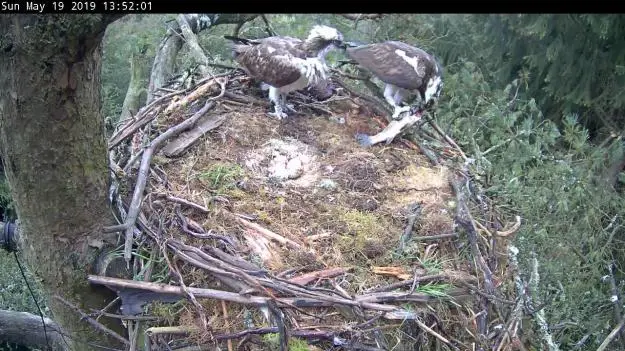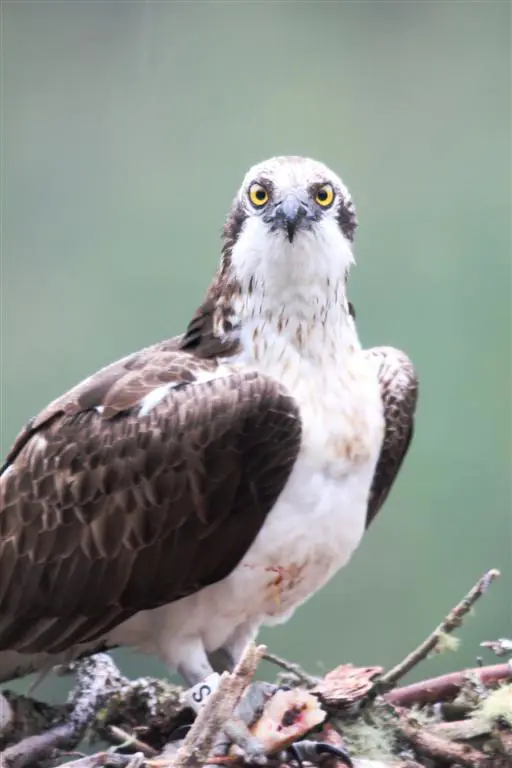The story of SS
Our live camera feed is back up!
The live camera feed hosted by Forestry and Land Scotland is currently back up and running. The feed suffers from slow broadband issues, but we have people in the field working on a solution. Although intermittent at times, the feed is back. You can still see videos from the feed, updated every week, on our Osprey Playlist. Here are the highlights from this week!
This week’s osprey highlights from the Tweed Valley. Click to play.
Where is SS?

SS returned with a fish for Mrs O
The main nest remains a place of quiet domesticity again this week. The pair are waiting for the eggs to incubate, but the process is a long wait. Mrs O also had a long wait for her partner, SS, to return to the nest at the weekend. Volunteers were concerned that SS had not been seen at the nest for two days during volunteer shifts, so it was with a sigh of relief that they saw SS finally fly in with a good-sized fish on Sunday.
Fish are messy meals

A messy fish meal leaves sticky feathers on his beak
Judging by Mrs O’s attitude, he must have been back at other times with fish because her actions were not that of a ravenous, abandoned, damsel in distress, but rather a ‘lady who lunches’. She rose from her egg-sitting spot and took the headless trout from SS, carried it in her talons up to the perch above the nest and tucked in, devouring every morsel including the tail in a leisurely fashion.
The whole meal took 35 minutes, and she was a very contented, well-fed mother to be. Meanwhile, SS took a turn to keep the eggs warm while she was eating. The spoils of his catch, in the form of sections of fish head, were clearly sticking to his beak. The sticky blood caused some downy feathers to stick to his bill. He was most in need of a napkin to save his stately demeanour but needs must and a good scrub against some nest sticks brought him back to his usual well- groomed look.
The life story of SS

A handsome SS photo taken in 2012 by Tony Lightley
Because white leg SS is 20 years old this year, a check back through the records to look at his life history and that of his offspring proved to be quite revealing.
SS fledged from a nest in Aberfoyle in 1999 and was fitted with his white leg ring, SS, on the right leg. He moved to Tweed Valley in 2004, and it has been his summer residence ever since. He was with his original partner until she died in 2014. They successfully raised 26 chicks between them.
We do not know where he spends his winters. Every year he leaves Tweed Valley in September and does not return until the following year in March or early April. We presume he goes to Senegal or Gambia, a popular osprey winter haunt, but he has never been spotted there or anywhere on his journey north or south. An international bird of mystery, a regular James Bond hero, or just plain SS, an ordinary migrating bird doing what he does best.
When his partner died in 2014 we witnessed it all from the live camera and it was heart breaking to see the desolate figure of SS, at the nest and his 3 dead chicks. They died because they had not had a mum to keep them warm while SS went out to hunt.
We were absolutely thrilled when he returned in 2015 and found a new mate, and they raised one chick (FX9), which sadly disappeared a week after fledging. In 2016, another new partner arrived for SS. This was a young female from the Muir of Ord, but again the summer ended tragically with one egg unhatched. The one chick that did hatch died in the nest. AS6, the young female, never returned to nest with SS again.
Then, in 2017, the indomitable Mrs O arrived and they became a pair. They were too late in the season that year, and didn’t produce any eggs. Mrs O squawked her way through the summer and was quite aggressive towards SS at times. But in 2018, they cemented their partnership and raised Tweedledum and Tweedledee. Sadly, tragedy again struck, the two chicks never made it out of the UK on migration.
This year, Mrs O and SS have three eggs and we are hoping that they will have a happy season. We are looking forward to 3 little chicks soon.
The Offspring of SS
In total, SS, had 29 offspring which fledged from the main nest. We know that at least 4 of those successfully went on to breed. His son from 2006, yellow 80, nested at Caerlaverock in 2013 and 2014, and returned again this year. One of his daughters from 2007, white HA, nested in Stirlingshire from 2012 to 2016.
A daughter, CK2 , from the main nest in 2012 began to nest in Esthwaite in 2015. One of SS’s sons from 2013, CL6, moved to the Highlands and took up a nest site with a 25 year-old female bird.
One of his daughters from the 2010 nest, HF, was seen in Wales at the Dyfi nest in 2012. Another of his offspring , CL4, that fledged in 2013 visited her natal nest site in August 2015 while her father was not there, and was seen again in the Algarve in 2016.
SS birthday party – you’re invited!
Another reminder for past volunteers to get in touch if they would like to celebrate SS being 20 years old this year on 8 June.
Contact Diane on Tweedvalleyospreys@gmail.com to confirm your attendance. We would love to celebrate with all past and present volunteers and project supporters, and share a few stories. There’ll be a chance to show off your osprey-themed talents too, be they arty, crafty, wordy, ‘techy’, musical or just plain daft!
Volunteer with us
If you would like to be a volunteer at the osprey centres at Glentress Forest WildWatch Room and Kailzie Gardens, Nature and Osprey Watch, then please get in touch by email at tweedvalleyospreys@gmail.com.
We really do need some more volunteers for this season to monitor the cameras and to keep a log diary of osprey activity, and to chat to visitors to tell them what is happening at the nest sites which are live on camera. Volunteers also play a vital role in recording footage from the live camera. Training will be given, so no previous experience is needed.